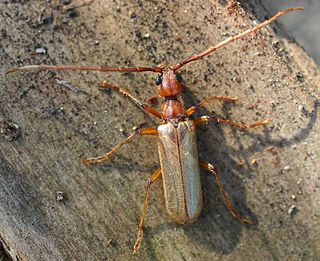
The longhorn beetles are a cosmopolitan family of beetles, typically characterized by extremely long antennae, which are often as long as or longer than the beetle's body. In various members of the family, however, the antennae are quite short and such species can be difficult to distinguish from related beetle families such as the Chrysomelidae. The family is large, with over 26,000 species described, slightly more than half from the Eastern Hemisphere. Several are serious pests. The larvae, called roundheaded borers, bore into wood, where they can cause extensive damage to either living trees or untreated lumber. A number of species mimic ants, bees, and wasps, though a majority of species are cryptically colored. The rare titan beetle from northeastern South America is often considered the largest insect, with a maximum known body length of just over 16.7 cm (6.6 in). The scientific name of this beetle family goes back to a figure from Greek mythology: after an argument with nymphs, the shepherd Cerambus was transformed into a large beetle with horns.

The Chrysomeloidea are an enormous superfamily of beetles, with tens of thousands of species, mostly in the families Cerambycidae and Chrysomelidae, the leaf beetles.
Charles Joseph Gahan was an Irish entomologist who specialized in beetles particularly the Cerambycidae. He served as keeper at the department of entomology in the British Museum for thirteen years after Charles Owen Waterhouse.

The Prioninae are a subfamily of Cerambycidae. They are typically large (25–70 mm) and usually brown or black. The males of a few genera sport large mandibles that are used in fights with other males, similar to stag beetles. These beetles are commonly nocturnal and are attracted to light. The majority of the Prioninae whose biology is known are borers whose larvae feed on rotting wood or roots.

Powderpost beetles are a group of seventy species of woodboring beetles classified in the insect subfamily Lyctinae. These beetles, along with spider beetles, death watch beetles, common furniture beetles, skin beetles, and others, make up the superfamily Bostrichoidea. While most woodborers have a large prothorax, powderpost beetles do not, making their heads more visible. In addition to this, their antennae have two-jointed clubs. They are considered pests and attack deciduous trees, over time reducing the wood to a powdery dust. The damage caused by longhorn beetles is often confused with that of powderpost beetles, but the two groups are unrelated. The larvae of the Cerambycidae are white, straight and generally flat-headed, whereas those of the Bostrichidae are white and C-shaped.

Per Olof Christopher Aurivillius was a Swedish entomologist.

The Disteniidae are a small family of beetles in the superfamily Chrysomeloidea, traditionally treated as a group within the Cerambycidae.

The Vesperidae are a small family of beetles, normally classified within the family Cerambycidae, of heterogeneous aspect but all characterised by larval stages related to roots of herbaceous plants or trees

Necydalinae is a small subfamily of the longhorn beetle family (Cerambycidae), historically treated as a tribe within the subfamily Lepturinae, but recently recognized as a separate subfamily. These beetles are unusual for cerambycids, in that the elytra are quite short; they are thus rather similar in appearance to rove beetles, though most are actually bee or wasp mimics.

Lepturinae, the lepturine beetles, is a subfamily of the longhorn beetle family (Cerambycidae), containing about 150 genera worldwide. This lineage is most diverse in the Northern Hemisphere. Until recently the subfamily Necydalinae was included within the lepturines, but this has been recently recognized as a separate subfamily. Nine tribes are usually recognized today, with a tenth, Caraphiini, created in 2016. A few genera are of uncertain placement within the subfamily.

Dorcasominae is a subfamily of the longhorn beetle family (Cerambycidae). The family includes only two tribes, Apatophysini and Dorcasomini, but numerous genera.

Cerambycini is a tribe of longhorn beetles classified under the subfamily Cerambycinae. It contains 30 genera.

Trachyderini is a tribe of long-horned beetles in the family Cerambycidae. There are at least 140 genera and 650 described species in Trachyderini.
Heterachthes hystricosus is a species of beetle in the family Cerambycidae. It was described by Martins in 1971.
Praxithea javetii is a species of beetle in the family Cerambycidae. It was described by Chabrillac in 1857. The holotypes were collected in Brazil.

Thryallis ocellatus is a species of beetle in the family Cerambycidae. It was described by Chemsak and McCarty in 1997.
Hilaroleopsis nigerrima is a species of beetle in the family Cerambycidae. It was described by Per Olof Christopher Aurivillius in 1923. It is known from Guatemala and Mexico.
Eurysops insignis is a species of beetle in the family Cerambycidae. It was described by Per Olof Christopher Aurivillius in 1910.
Gemylus albovittatus is a species of beetle from the family Cerambycidae. The scientific name of the species was first validly published in 1960 by Breuning.












